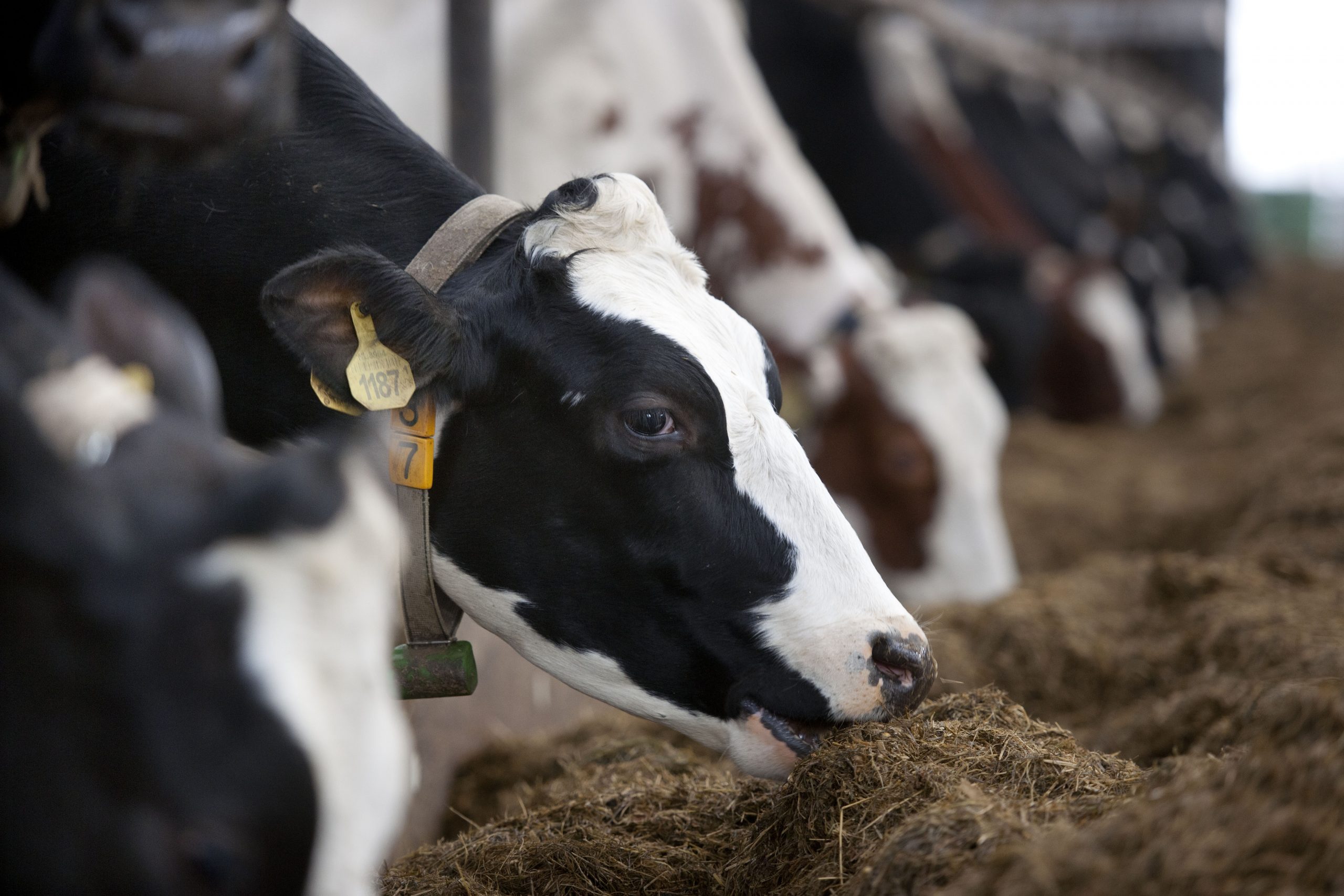Adding the rumen modifier effect to the matrix

If you feed a supplement that impacts the rumen, what does this mean for animal feed efficiency? And should this effect be incorporated into diet formulation programmes to optimise dairy farm revenue? In this article we explore this theory in further detail.
In monogastric diet formulation programmes, several feed additives, such as enzymes, are now well accepted for improving the productive value of commercial feeds and allowing greater flexibility in feed formulation (least cost formulations). These technologies are supported by documented and positive responses on the digestibility of feeds.
But what about ruminants?
Rumen modifiers are defined as “feed additives which alter ruminal fermentation, microbial growth, and have a positive impact on feed efficiency” (Calsamiglia et al., 2006). Potential additives include ionophores, live yeasts, fermentation products, essential oils or enzymes. To be used in a diet modelling approach, these rumen modifiers should be proven to have the capacity to modify some key steps of the biological process of rumen digestion. Furthermore, those mechanistic effects need to be validated by practical responses on feed efficiency and commercial production. Hence, the objective of this article is to present the potential a specific live yeast strain has on rumen fibre degradation enhancement, the role pH plays on the extent of this feature and how this synergistic effect has been included in a dynamic nutrition model, before sharing the outcomes of one field validation of the milk prediction.
Making the most of the fibre fraction
With intensive production, rumen function optimisation is a key target to improve animal production efficiency. This is because the rumen hosts a complex anaerobic microbiota responsible for degradation and fermentation of the main part of dietary components ingested by the animal.
However, many factors can impair rumen function. In this context, microbial feed additives such as live yeasts are an important tool to improve feed efficiency and performance. Live yeast strain Saccharomyces cerevisiae CNCM I-1077 has been specifically selected for its activity in the rumen and benefits today from a robust scientific documentation regarding its effects and modes of action (Figure 1).
Figure 1 – Overview of Saccharomyces cerevisiae CNCM I-1077 documented effects in the rumen (over 100 scientific communications on this yeast strain).

In sacco trials demonstrate its positive impact on the degradability of the neutral detergent fibre fraction (NDF) of more than 200 different forage samples, including: corn silage, straw, rye grass hay, alfalfa hay, annual rye grass (pasture), meadow hay, grass silage etc. S. cerevisiae CNCM I-1077 is found to increase NDF digestibility by 3 to 8 units, depending on the type of forage and its own degradability (Guedes et al., 2008; Chaucheyras-Durand et al., 2010, Ding et al., 2014, Guedes et al., 2015). The mechanism of action of S. cerevisiae CNCM I-1077 on rumen fibre degrading activities is based on stimulating and encouraging the colonisation of specific rumen bacteria and fungi and promoting substrate access. A huge portion of the rumen cellulolytic flora is considered as strictly anaerobic. Oxygen scavenging by live yeast in the rumen is an advanced mode of action for enhanced fibrolytic activity (Figure 2).
Figure 2 – A proposed scheme for mode of action of S. cerevisiae CNCM I-1077 on fibre degrading communities (Chaucheyras-Durand et al., 2016).

Modulated by rumen pH
Rumen cellulolytic activity is affected by rumen environment (Michalet-Doreau and Morand, 1997), pH in particular. Thus, regulation of pH to non-acidotic levels positively influences the fibrolytic flora and digestibility performance of multiple raw materials. Indeed, lower rumen pH decreases NDF digestibility (Noziere et al., 2010, Fox et al., 2003) (Figure 3). S. cerevisiae CNCM I-1077 has a well-documented effect on rumen pH, which has been recorded in a dataset composed of multiple diet composition and environmental challenges. Results show that supplemented cows have maintained higher ruminal pH compared to the control.
Figure 3 – Impact of the rumen pH on the NDF digestion rate of a raw material (from Fox et al., 2003).

Prediction model
Significant progress has been made in model refinements over the past years through the inclusion of biological and dynamic pathways for ruminant digestion. These non-linear refined models provide a path for innovative formulation systems which offer opportunities to fine-tune the prediction of the nutritional values of diets, including potential sub-models with rumen modifier. In the case of S. cerevisiae CNCM I-1077, prediction of nutrient digestibility can be made through rumen input, coupling effect of pH and NDF digestibility. The response will vary with forage types (NDFd effect) and starch concentration (pH effect).
As an example, on a standard TMR corn silage based dairy diet, biological sub-model Cornell Net Carbohydrate and Protein System (CNCPS) can predict an increase of milk production and of milk per kg of dry matter intake of up to 4%. The accuracy of prediction is further supported by the positive impact on ruminant zootechnical performance, practically measured for milk and meat type ruminants. Taking the example of dairy cows, in a meta-analysis considering multiple studies with dairy cows placed under conventional management, De Ondarza et al., (2010) concluded that S. cerevisiae CNCM I-1077 supplementation has led to a significant average milk yield and feed efficiency increase (P<0.001).></0.001).>
Field validation
In order to validate the sub-model, a trial was conducted by Toulouse Purpan Agriculture College, comparing real-life to predicted results (Ali Haimoud-Lekhal et al., 2016). The trial was conducted on 38 Holstein cows in total (115 days in milk, fed a fibre rich diet: Corn silage (NDFd30h=56.0%; 67% on dry matter basis), Alfalfa hay (NDFd30h=32.9%; 14%), Concentrate (including 150g of sodium bicarbonate; 19%). Animals were divided into 2 groups, control and live yeast, the latter receiving the standard dose of 10 billion CFU/cow/day S. cerevisiae I-1077. Prediction of milk production is seen in Table 1; the database on fibre digestibility enhancement modulated by the rumen pH improvement (predicted NDFd) with this rumen specific live yeast allows to model an increased diet energy value (predicted Net Energy of Lactation) and thus milk production.
Table 2 shows the trial results: the measured milk production is very close to the prediction, for both the control and live yeast group: 30.1 kg milk/day in real life situation vs. 30.2 in the model for live yeast. Additionally, the performance trial further confirms the benefits of the rumen modifier on animal performance: milk components and feed efficiency are improved to levels similar to the literature.
Conclusion
A large amount of data concerning rumen specific live yeast modes of action and benefits supports the prediction of its effect on ruminant performance. This represents a valuable tool to allow maximising the forage portion of the diet, giving the farmers, feed manufacturers or nutritionists the possibility to either increase milk or meat revenue per kg of feed, or to optimise feed cost with similar milk or meat revenue. The present study confirms the relevance of a sub-model which enables to take into account the quantitative response of live yeast within a feed formulation programme. Hence, this innovative approach for a live yeast predictive effect on milk yield grants dairy feed formulators access to a new decision-making tool offering a quick and reliable prediction. It provides thus the opportunity to fine-tune diet composition in order to answer specific producers’ demands to optimise their farm performance.
References are available on request.











